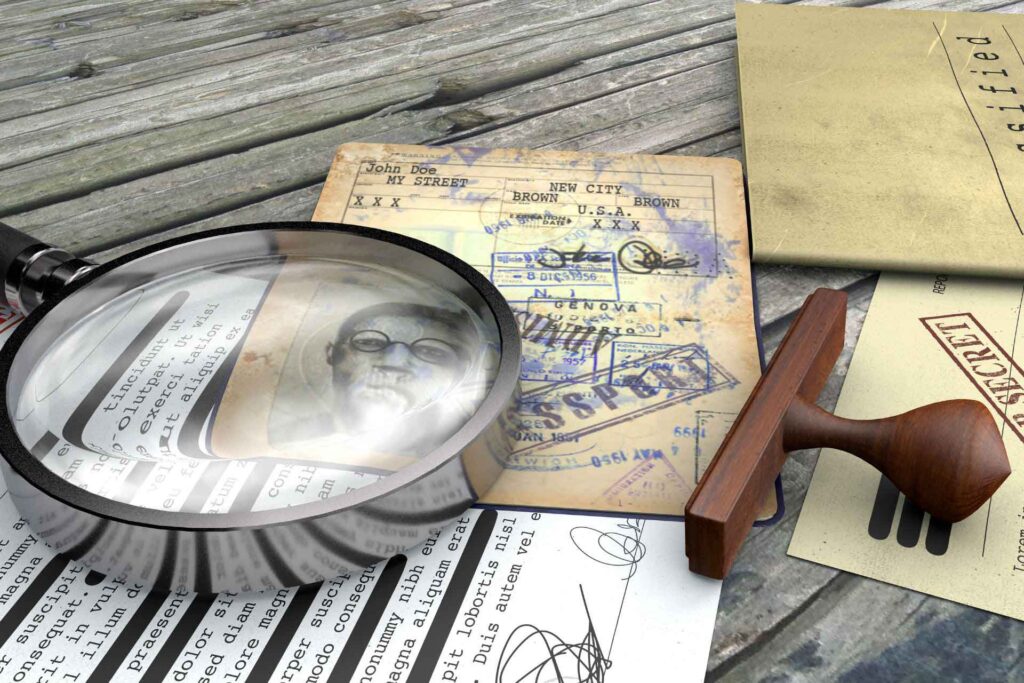Have you ever wondered what information your passport reveals to immigration officers as it passes through the scanner? Do they really know everything about you, from historical records to social media posts?
Your passport transforms into a digital X-ray in the quiet of the immigration line, revealing more than meets the eye. But fear not! This article decodes passport scans and reveals the truth about what immigration can (and cannot) see when they inspect you.
Understanding the Mechanics of Passport Scans:
The process of scanning your passport at immigration may appear complex, but it’s grounded in straightforward technology. Let’s break down what happens when the officer swipes your passport through the scanning device.
1. The technology used to Scan passports:
The magic of passport scanning relies on Near Field Communication (NFC) technology. Embedded within your passport’s cover is an RFID chip that contains crucial information. No physical contact is needed; placing your passport near the scanner initiates a secure data exchange.
2. Information Extracted from passport scans:
Think of the chip as a digital repository for key details of your travel identity. The scan reveals basic information such as your full name, photograph, nationality, and date of birth – essentially, a digital version of the biographical page in your passport. However, it’s important to note that the scan doesn’t delve into your travel history or online activities.
3. Biometric Inclusions (in Some Cases):
In certain passports, the chip may also store biometric data, like fingerprints or facial scans. This additional layer enhances security and serves as a deterrent against document forgery. Notably, not all passports worldwide incorporate this feature.
4. Understanding the Scan’s Limitations:
Here’s the crucial point: while the scan provides access to fundamental identity information, it’s only the beginning of the immigration officer’s evaluation. Details about your travel history, social media presence, or personal collections are not visible during the scan. They are stored in separate databases and can only be accessed through specific queries and investigative procedures. The scan offers a glimpse but doesn’t uncover the complete picture.

Also Read: The Ultimate Guide to Immigration: From Dream to Reality
Types of information immigration can access:
To ensure border security and control who enters and who does not, immigration authorities use a variety of tools and databases to learn more about applicants and whether they are trustworthy and safe to enter the country. Understanding the various types of information available to them gives them insights into whether to approve or decline the application.
1. Basic Details:
Basic details form the foundation of identity verification during immigration checks. These include your legal name, passport information, citizenship, and relevant travel documents. This information ensures accurate identification and adherence to entry requirements.
- Name: The name as stated on your passport, serving as a primary identifier.
- Passport Information: Details such as passport number, issue and expiration dates, and issuing country.
- Citizenship: Your nationality as indicated on official documents.
- Travel Documents: Additional documents like reservations, invitations, or letter of approval, essential for lawful entry.
2. Travel History:
Examining an individual’s travel history assists immigration in determining the patterns of his movements, such as how many countries he has visited, and what types of countries he has visited. All of this contributes to border security and adherence to visa regulations.
- Entry/Departure Records: A chronological record of entries and exits from various countries.
- Border Crossing Logs: Information detailing how and where you crossed borders.
- Airline Passenger Manifests: Collaboration with airlines provides insight into your travel history.
3. Government Databases:
The access granted to government databases is a pivotal component of border control, empowering immigration authorities to stay vigilant and informed. This access serves as a crucial line of defense, ensuring a thorough understanding of an individual’s background regarding criminal records, adherence to immigration laws, and potential security implications.
- Criminal Records: Immigration authorities meticulously check for any history of criminal activity linked to the individual. This involves querying databases that house comprehensive criminal records, ranging from minor offenses to more serious felonies. Identifying criminal history is paramount for assessing potential threats to public safety and national security.
- Immigration Violations: The focus is on uncovering any breaches of immigration laws, ensuring compliance with visa conditions and entry requirements. Immigration authorities review databases containing information on visa overstays, unauthorized employment, or violations of entry conditions.These violations aids in upholding the integrity of the immigration system and enforcing legal immigration protocols.
- Security Watchlists: Immigration authorities employ advanced scanning techniques to identify individuals listed as potential risks or threats.Regular and systematic scans of watchlists, which include individuals with suspected links to criminal or extremist activities, are conducted. This proactive approach enhances national security by preventing the entry of individuals deemed potential risks based on intelligence and security assessments.
4. Public Information:
Immigration authorities harness the power of publicly available information to paint a more comprehensive picture of an individual’s background.
- Financial Records (with Warrants): Authorized access to financial records aids in the investigation and understanding of an individual’s financial situation. This access provides critical information about an individual’s financial stability and ability to fund himself during his stay.
- Social Media: What you post on social media is monitored. They examine the profiles to learn about an individual’s associations and activities. What if you share things that go against the country’s values and standards?
- Marital Status: Awareness of an individual’s marital status adds another layer to understanding their background. This information can be obtained through official documents or, in some cases, public records.

How does immigration know your travel history?
Every border crossing becomes an entry in a global travel diary accessible to officials. Here’re the systems used to track your movements.:
- Advance Passenger Information System (APIS): Before your flight, airlines submit data such as your name, passport number, travel itinerary, and booking details to immigration authorities. This gives them an idea of who is coming and allows for preliminary checks.
- Passenger Name Record (PNR): This detailed airline reservation record contains information other than APIS, such as contact information, emergency details, travel agent data, and even meal preferences. However, access to PNRs is typically restricted and requires specific justification.
Data Sharing across Borders:
These systems aren’t solitary islands. International agreements like Schengen, the Five Eyes network, and bilateral data exchange partnerships enable seamless transmission of your travel data between countries. This collaborative approach strengthens border security by identifying potential risks and ensuring compliance with visa requirements.
What Immigration Can’t See (or Shouldn’t See):
Understanding what immigration can’t see is as crucial as knowing what they can access. While immigration authorities have access to a range of information, there are limitations to their visibility. Here’re the aspects that remain beyond the purview of immigration check:
- Private Communications: Immigration authorities generally do not have access to your private communications, including emails, text messages, or phone calls, unless there is a specific and legally justified reason for surveillance.
- Detailed Financial Transactions: While immigration can access certain financial records with legal warrants, they typically do not have real-time access to your detailed financial transactions unless it’s related to a specific investigation.
- Personal Relationships Outside Legal Documentation: Immigration authorities primarily rely on official documents to verify relationships (e.g., family ties). They don’t have access to the intricacies of personal relationships outside what’s documented.
- Unrelated Legal Records: Unless relevant to immigration concerns, authorities typically don’t have access to an individual’s unrelated legal records, such as civil cases or non-immigration-related legal matters.
- Specific Health Information: Immigration authorities may be aware of basic health checks required for entry, but they generally don’t have access to detailed personal health records without your consent.
Understanding what immigration knows, from basic details to travel footprints is crucial in empowering you to navigate this process with confidence. Embrace transparency, respect regulations, and travel responsibly.
For in the end, borders may divide lands, but curiosity and knowledge can bridge the gap, paving the way for a world where every movement is a chance to connect, not confine.
More sources:



